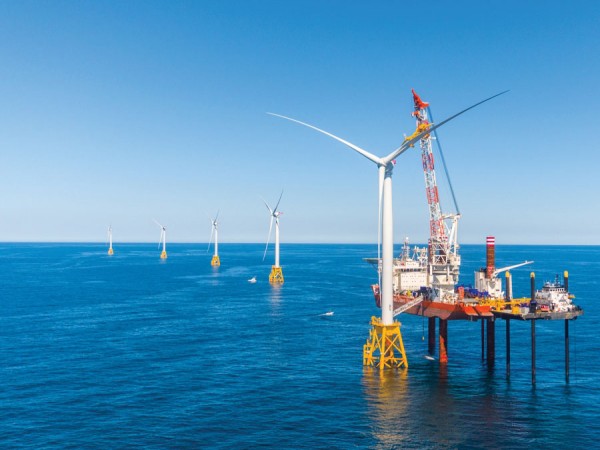Policy hurdles may be more formidable than technical issues in the US.
Wind is become a growing part of the energy mix, both in the United States and globally. Some of the world’s largest terrestrial wind farms are being developed in places like Utah and Wyoming.
Major energy companies, like Statoil, the Norwegian multinational and the largest offshore oil drilling operator, is looking to diversify to wind energy, getting involved in large projects around the world, including the United States.

There are a number of obstacles that make the widespread development of offshore wind farms less than a foregone conclusion, especially in the U.S. Technical issues abound, to be sure, but these are being met by a flurry of innovation activity.
The thornier issue in the U.S. revolves around governmental policy. The president himself has expressed skepticism of wind energy, telling an audience in Iowa last June, “I don’t want to just hope the wind blows to light up your house and your factory.”
The Trump administration has evinced a clear preference for developing the country’s fossil fuel resources, pushing to open drilling on the U.S. coasts just about everywhere. The Interior Department’s Bureau of Ocean Energy Management (BOEM), which actively developed leases for offshore wind generation during the Obama administration, has announced only one new lease since Trump took office, and that was last March.
Then there is the matter of the Jones Act. If wind developers are required to use U.S. vessels and crews to transport equipment offshore, it will increase their costs and provide a disincentive to investment.
That’s not to say that Trump policies can stop the development of wind energy in its tracks. Although the Trump administration appears to be rolling back renewable energy goals set by former President Barack Obama, many states and even private utilities have their own renewables programs. New York State has a goal of 50% renewables for the electric grid by 2030. Statoil is helping the state achieve that goal, after successfully bidding in a federal auction in December 2016 on the Empire Wind project, a 79,000-acre area 11 miles off of Long Island designated by New York State for wind power generation.
Offshore Wind and the Jones Act
The technical issues relate mainly to the relocation of new offshore wind energy projects from shallow water to depths of 50 meters or more. Deepwater farms are more efficient and generate more power thanks to faster wind speeds, but are also more expensive and present obvious challenges. But given the expected growth in offshore wind, it’s not surprising that innovations are coming down the pike with great haste.
For example, in December 2017, Ampelmann, a company that provides offshore access solutions, announced it had created an angular boom tip to allow workers at a North Sea project off Scotland access to more easily install jackets for 84 wind turbines. In November, Statoil awarded a contract for a battery system to be connected to the first floating wind farm, also off the coast of Scotland.
That project, which started as a pilot in 2009, will reduce the cost of delivering electricity to 22,000 homes by 60 to 70 percent, according to Lars Christian Bacher, the company’s executive vice president for international development and production. Recent developments in that project have the goal of “putting the whole factory on the seabed,” he said. “It’s not just a platform anymore.”
Statoil‘s strategy is to gradually supplement its oil and gas portfolio with renewable energy, to transition “from an oil company to energy company,” said Bacher. The value the company brings to that endeavor, he explained, is its experience in developing and managing large offshore oil drilling projects.
Statoil Wind US, a subsidiary of the formerly government-owned Norwegian company, is looking for projects to invest in the United States to supplement the existing Empire Wind, which will start producing electricity in 2024. Statoil is already involved in massive offshore wind energy projects in Europe, one of which will require the deployment of 4,000 vessels to being to fruition.
“But because of the Jones Act there are limitations on the vessels we can use” in a comparable project in the U.S., said Knut Aanstad, president of Statoil Wind US. Aanstad suggested that those legislative requirements could impede a company such as his from going all-in on wind projects because of the scale that such a project would require to make it worthwhile.
The Jones Act, passed in 1920, prohibits a foreign vessel from transporting merchandise between points in the United States. The act also applies to shipments from points on the North American continent to installations on the Outer Continental Shelf, hence its applicability to offshore wind installations. A violation of the Jones Act may result in the assessment of a civil penalty equal to the value of the merchandise.
There have been attempts to repeal or reform the Jones Act for decades, all without success. If anything, the pendulum is now swinging in the direction of greater enforcement, with the creation within US Customs and Border Protection in 2016 of the Jones Act Division of Enforcement (JADE). JADE was stood up primarily, it is presumed, to catch Jones Act violators in the offshore oil and gas industries, but it could just as easily be used in connection with wind farm operators. In early 2017, the Department of Justice settled a case which included payment by a shipping company of a $10-million penalty, the biggest ever under the Jones Act.
While the Jones Act may be one hurdle, disarray in US government policy is probably the biggest challenge for energy producers. Those companies make massive commitments of up-front capital with the expectation of healthy cash flows from projects for at least 20 years.
“The greatest danger to business is the lack of predictability,” said Aanstad. “The market needs clarity to see when and where capacity needs to be made available.”





